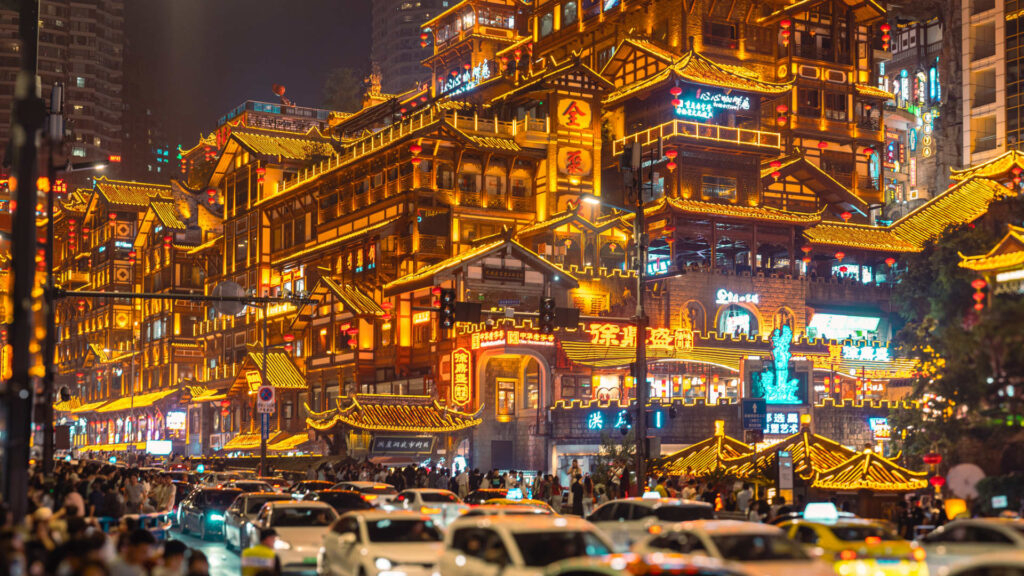Chongqing, China.
Jackyenjoyphotography | Moment | Getty Images
A new trend is attracting Southeast Asian visitors to Chongqing, a city in China, thanks to viral social media videos showcasing its monorails that pass through residential buildings, structures built on steep hills, and a pedestrian bridge situated on the 13th floor.
During this year’s Dragon Boat Festival, which occurred on May 31, flight reservations from Southeast Asia to Chongqing surged more than six times compared to last year, according to the Chinese travel platform Fliggy.
“By 2025, we’ve noted an impressive nearly 12-fold increase in the demand for Chongqing compared to other cities,” stated Sarah Wan, Klook’s general manager for Indonesia, Malaysia, and Singapore, via email. She noted that demand for other popular destinations like Beijing and Shanghai only doubled, while it tripled for Chengdu.
What Makes Chongqing Attractive?
Chongqing has gained attention online for its striking contrast, featuring stunning natural sites such as the Three Gorges and the Dazu Rock Carvings alongside futuristic buildings, earning it the nickname “cyberpunk city.”
This trend is largely fueled by young travelers, as 79% of millennials and Gen Z consumers seek travel recommendations on social media, based on Klook’s Travel Pulse research conducted in February.
This was true for Ong Chong Yu, a 24-year-old student at the National University of Singapore, and his friends, who decided to explore the city after it went viral on Douyin and TikTok for its “8D magic,” which highlights how the city’s buildings are integrated into its mountainous landscape, creating a unique multi-layered look.
Ong, a Chinese studies major on exchange in Beijing, visited Chongqing on a weekend trip in March and shared that the city’s distinctive terrain left a lasting impression on him.
“It necessitates climbing up and down mountains to get between roads; one building’s ground floor could very well be the equivalent of another’s 15th floor,” he remarked.
In addition to the buzz from social media, enhancements in amenities and a variety of attractions have contributed to the city’s rising fame.
According to Edmund Ong, senior regional director at Trip.com, “Chongqing offers a wide range of activities, ensuring there’s something for everyone.” He noted, “While older generations appreciate its beautiful landscapes like the Yangtze River and Three Gorges, younger visitors are drawn by locations that have gone viral online.”
However, stunning views are just one aspect of a successful trip.
Though Chongqing has seen a rise in visitors since Ong’s last visit in 2018, he expressed his approval of the city’s effective crowd management, stating that navigating through the city was surprisingly organized.
Gao Ling, director-general of the Chongqing Municipal Commission of Culture and Tourism Development, explained that the city is focused on enhancing travel ease for tourists through investments in transport infrastructure. Efforts include greater connectivity to major cities like Beijing and Chengdu by air and rail, making it simpler for visitors to access Chongqing.
Earlier this year, the municipality also launched one-stop service points at key transit locations, including Jiangbei International Airport and Chongqing North railway station, providing storage for luggage and traveler information stations.
Gao added that the proximity of Southeast Asia to China makes it an appealing destination for young travelers.

Trip.com has noted that Singapore, Malaysia, and Thailand account for the highest number of bookings to Chongqing from Southeast Asia, facilitated by visa-free access to China. Similarly, Klook highlighted that tourists from these nations are leading in tour sales, with visitors from Thailand and Indonesia also contributing to growing demand.
According to Fliggy, hotel reservations from Thai travelers to Chongqing have surged over five times recently.
China’s Growing Attractiveness
The excitement surrounding travel isn’t just limited to Chongqing; interest is increasing across numerous cities in mainland China.
Klook’s Travel Pulse research indicates that mainland China stands out as the premier “must-visit destination” for millennials and Gen Z, second only to Japan. The country’s allure for younger travelers can be linked to cultural experiences that include themed photoshoots and live performances that feature singing and dancing, according to Elvis Yap, a travel design planner at Dynasty Travel in Singapore.
The themed photoshoots, where tourists wear traditional attire, have gained immense popularity on social media, driving demand for such experiences. Travelers, both local and international, are sharing photos online dressed in traditional Han outfits, complete with wigs and elaborate makeup provided during the service.
Another trending experience is “gong yan,” a multi-course banquet accompanied by performances where attendees can wear traditional clothing as well, providing a vibrant mix of cultural arts with dining at an affordable cost, especially favorable for those converting Singapore dollars into yuan.
Beyond social media trends, improvements in hospitality are enhancing the visitor experience, with hotels and attractions offering more appealing services, he noted.
Yap added, “Other countries in Asia should be aware of the competitive landscape shaped by China’s hospitality offerings.”

